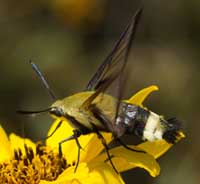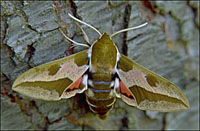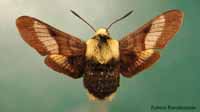|
|
Updated as per James P. Tuttle's The Hawk Moths of North America, September 23, 2011
Updated as per BAMONA, September 23, 2011
|
Wheatland County, Montana
Sphingidae
Fourteen Sphingidae species are listed on the BAMONA
checklist for Montana as of September 23, 2011. I have added some species to Montana which I feel are
likely present. Not all of the species are reported or anticipated in
Wheatland County (No Sphingidae are reported on BAMONA as of September 23, 2011).
It is hoped that
this checklist, with the thumbnails and notes, will help you
quickly identify the moths you have encountered.
A "WO" after the species name indicates that
I have no confirmed reports of this species in your county, but I
(William Oehlke) expect that this moth is present or
might be present. A
BAMONA indicates the
moth is reported on the BAMONA website and/or in Moths of Western North America,
#2. Distribution of Sphingidae of Western North America, revised,
an excellent little booklet available through Paul Opler.
Please help me develop this list with improved, documented accuracy by
sending sightings (species, date, location), preferably with an
image, via email to
Bill Oehlke.
Please also send your sightings to BAMONA, an excellent online resource.
Sphinginae subfamily
Sphingini tribe:
 |
Sphinx drupiferarum larvae hide in the day and feed primarily on
cherry, plum, and apple at night.
|
 |
The upperside of the forewing has a narrow black subterminal line
bordered by a white inverted V-shaped line on the outside, and a
black line running inwards from the apex of the wing.
It is most often found in montane woodlands and along streamcourses.
|
Smerinthini Tribe:
 |
Pachysphinx modesta
WO,
the Modest Sphinx or Poplar Sphinx,
This moth has a large, heavy body, and females
can be remarkably plump.
|
 |
This one is quite similar to Pachysphinx modesta, with modesta
being smaller and darker. There are two color forms: the upperside of the forewings is yellow brown in the pale form and dark gray in the dark form.
Lines and bands are well-defined.
|
 |
The grey-blue eyespot of the hindwing gives this species its name.
Larvae feed on birches, willows, cherries and oaks.
The outer edge of the forewings is quite scalloped.
|
 |
This small species is probably widespread and common. This species ranges across North America.
The hindwings have a small blue eyespot ringed with black on a yellow background.
|
 |
If you have willows and poplars nearby, you've probably got populations of
the Cerisyi's Sphinx. The hindwings are quite striking.
|
Macroglossinae subfamily
Dilophonotini tribe
 |
Hemaris diffinis
WO,
the Snowberry Clearwing or Bumblebee Moth
The wings are basically clear, with dark brown to brownish-orange
veins, bases and edges. The thorax is golden-brown to dark
greenish-brown. The abdomen tends to be dark (black) with 1-2 yellow
segments just before the end.
|
 |
Hemaris thetis
WO,
the Thetis Clearwing or Bee Hawk Moth,
The moth flies along forest edges and in meadows, gardens and
brushy fields. Day-flying adults nectar at lantana, dwarf bush honeysuckle,
snowberry, orange hawkweed, thistles, lilac, Canada violet, etc. West of Continental Divide.
|
Philampelini tribe:
 |
This moth is not officially reported for Hampden,
but it is fairly often reported
along the coast from southern New Jersey
to central Maine. It ranges as far west as California.
|
Macroglossini tribe
 |
Hyles euphorbiae
WO,
the Spurge Hawk Moth
The body is light brown with various white and dark brown
markings, while the wings have a conspicuous tan, brown, and pink or
red color pattern.
probably will expand there if not already present
|
 |
Hyles gallii *
WO,
the Bedstraw Hawk Moth or Gallium Sphinx
This species is not officially reported from Cascade County; however,
if you have Gallium or Epilobium, you probably have
populations of this species.
|
 |
Hyles lineata *
WO,
the White-lined Sphinx
This species is very widespread. It can be seen flying during the day,
into the evening and also at night.
The highly variable larvae are often found in people's gardens.
|
 | Proserpinus flavofasciata adults fly from
April-June in meadows in coniferous forests. Adults fly during the
afternoon, nectaring from lilac, dandelion, cherry, etc.
|
|
|
Enjoy some of nature's wonderments, giant silk moth cocoons.
These cocoons are for sale winter and fall. Beautiful Saturniidae moths will emerge the following spring and summer.
Read Actias luna rearing article.
Additional online help available.
Eggs of many North American species are offered during the spring and summer. Occasionally
summer Actias luna and summer Antheraea polyphemus cocoons are available. Shipping to US destinations is done
from with in the US.
Use your browser "Back" button to return to the previous page.
This page is brought to you by
Bill Oehlke and the
WLSS. Pages are on space rented from Bizland. If you would like
to become a "Patron of the Sphingidae Site", contact Bill.
Please send sightings/images to Bill. I will do my best to respond to
requests for identification help.
 | 
Show appreciation for this site by clicking on flashing butterfly to the left.
The link will take you to a page with links to many insect sites. |
This website has been created and is maintained by Bill Oehlke without government or institutional financial assistance. All expenses, ie., text reference
support material, webspace rental from Bizland, computer repairs/replacements, backups systems, software for image adjustments (Adobe Photoshop; L-View),
ftp software, anti-virus protection, scanner, etc. are my own.
I very much appreciate all the many images that have been sent to me, or of which I have been granted permission to copy and post from other websites.
All images on this site remain the property of respective photographers.
If you would like to contribute to the maintenace of this website by sending a contribution to
Bill Oehlke
Box 476
155 Peardon Road
Montague, Prince Edward Island, C0A1R0
Canada
your donation would be much appreciated and would be used for
1) paying for webspace rental;
2) paying for computer maintenance and software upgrades;
3) purchases of additional text reference material (journals and books) in anticipation of expanding the site to a worldwide Sphingidae site;
4) helping to pay my daughter's tuition; with anything left over going to humanitarian aid.
If you are mailing a check from USA, please use $1.15 postage (2015 rate). Donations can also be made through Paypal via the button below.
